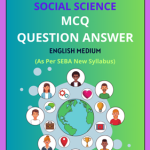SEBA Class 6 Social Science MCQ Chapter 5 Geographical study: Map Solutions in English Medium, Class 6 Social Science Multiple Choice Question Answer to each chapter is provided in the list so that you can easily browse throughout different chapters SEBA Class 6 Social Science MCQ Chapter 5 Geographical study: Map Question Answer and select need one.
SEBA Class 6 Social Science MCQ Chapter 5 Geographical study: Map
Also, you can read the SCERT book online in these sections SEBA Class 6 Social Science Objective Type Solutions by Expert Teachers as per SCERT (CBSE) Book guidelines. These solutions are part of SCERT All Subject Solutions. Here we have given Assam SEBA Class 6 Social Science MCQ Solutions for All Subject, You can practice these here.
Geographical study: Map
Chapter – 5
| MCQ |
1. Which of the following is used to represent the Earth’s surface on a flat piece of paper?
(a) Globe.
(b) Map.
(c) Diagram.
(d) Model.
Answer: (b) Map.
2. What is the term for the imaginary lines that run from the North Pole to the South Pole?
(a) Latitude.
(b) Longitude.
(c) Equator.
(d) Tropic.
Answer: (b) Longitude.
3. The line that divides the Earth into Northern and Southern Hemispheres is called the:
(a) Prime Meridian.
(b) Tropic of Cancer.
(c) Equator.
(d) Tropic of Capricorn.
Answer: (c) Equator.
4. Which of the following is not a type of map?
(a) Political map.
(b) Physical map.
(c) Thematic map.
(d) Mathematical map.
Answer: (d) Mathematical map.
5. Which type of map shows boundaries of countries, states, and cities?
(a) Physical map.
(b) Political map.
(c) Thematic map.
(d) Topographic map.
Answer: (b) Political map.
6. What does a physical map primarily show?
(a) Population distribution.
(b) Boundaries of countries.
(c) Natural features like mountains and rivers.
(d) Climate zones.
Answer: (c) Natural features like mountains and rivers.
7. Which map shows specific information such as climate, vegetation, or economic activities?
(a) Physical map.
(b) Political map.
(c) Thematic map.
(d) Road map.
Answer: (c) Thematic map.
8. The scale of a map indicates the:
(a) Distance between two points.
(b) Elevation of mountains.
(c) Depth of oceans.
(d) Population of a city.
Answer: (a) Distance between two points.
9. What does a topographic map show?
(a) Political boundaries.
(b) Road networks.
(c) Elevation and landforms.
(d) Weather patterns.
Answer: (c) Elevation and landforms.
10. Which line is at 0 degrees longitude?
(a) Equator.
(b) Tropic of Cancer.
(c) Prime Meridian.
(d) Tropic of Capricorn.
Answer: (c) Prime Meridian.
11. Which line is at 0 degrees latitude?
(a) Equator.
(b) Prime Meridian.
(c) Tropic of Cancer.
(d) Tropic of Capricorn.
Answer: (a) Equator.
12. What do contour lines on a map represent?
(a) Boundaries between countries.
(b) Changes in elevation.
(c) Population density.
(d) Climate zones.
Answer: (b) Changes in elevation.
13. A map key or legend explains:
(a) The title of the map.
(b) The scale of the map.
(c) The symbols and colours used on the map.
(d) The direction on the map.
Answer: (c) The symbols and colours used on the map.
14. The direction to the top of most maps is usually:
(a) East.
(b) West.
(c) North.
(d) South.
Answer: (c) North.
15. Which type of map would you use to find the height of a mountain?
(a) Political map.
(b) Physical map.
(c) Topographic map.
(d) Thematic map.
Answer: (c) Topographic map.

Hi! my Name is Parimal Roy. I have completed my Bachelor’s degree in Philosophy (B.A.) from Silapathar General College. Currently, I am working as an HR Manager at Dev Library. It is a website that provides study materials for students from Class 3 to 12, including SCERT and NCERT notes. It also offers resources for BA, B.Com, B.Sc, and Computer Science, along with postgraduate notes. Besides study materials, the website has novels, eBooks, health and finance articles, biographies, quotes, and more.




